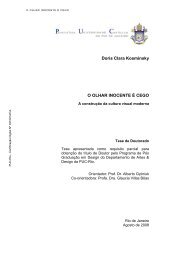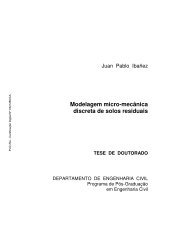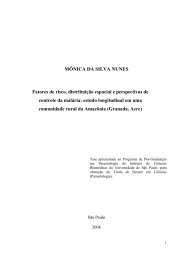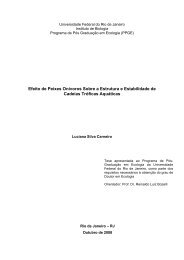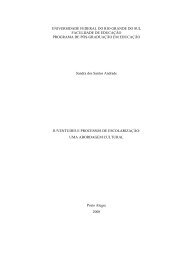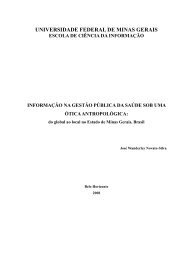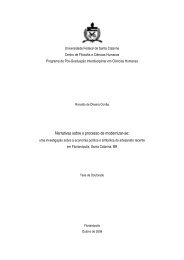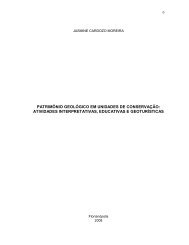You also want an ePaper? Increase the reach of your titles
YUMPU automatically turns print PDFs into web optimized ePapers that Google loves.
470 R.S. Car<strong>do</strong>so et al. / Molecular Immunology 43 (2006) 464–472DNA-binding subunit of DNA-PK, an important componentof the repair of DSB via NHEJ (Lees-Miller and Meek, 2003).Absence of Ku70 leads to hypersensitivity to ionizing radiation.Janus kinase 3 <strong>gene</strong> (JAK3, accession no. L40172,chromosome 8) codes for a tyrosine kinase of the nonreceptortype involved in the IL-2 and IL-4 signaling pathway.This <strong>gene</strong> belongs to the Tyr family of protein kinases and isimplicated in lymph gland development. The interleukin receptor<strong>gene</strong>s IL-11RA2 (accession no. X98519, chromosome4) and IL-7R (accession no. NM008372, chromosome 15) arealso present in cluster 3 and may later be associated with IL-7signaling, which plays a role in the V(D)J recombination ofTRs (Muegge et al., 1993; Sollof et al., 1997).In addition, we observed <strong>gene</strong>s associated with apoptosissuch as tumor necrosis factor receptor superfamily, member7 <strong>gene</strong> (TNFRSF7, accession no. L24495, chromosome 6)and GZMA (granzyme A <strong>gene</strong>, accession no. M13226, chromosome13). TNFRSF7 encodes a receptor for tnfsf7/cd27l,possibly playing a role in survival of activated T-cells, whileGZMA codes for a granzyme A precursor, an enzyme necessaryfor targeting cell lysis in cell-mediated immune responses.Therefore, the induction of several <strong>gene</strong>s in cluster 3 suggeststhe occurrence of T-cell differentiation following theirradiation stimulus in irradiated FTOCs.Cluster 4 (correlation = 0.81) contains <strong>gene</strong>s with inducedexpression in irradiated FTOCs similar to cluster 3. Amongthe modulated <strong>gene</strong>s, two may play a role in thymus morpho<strong>gene</strong>sisin FTOC, the fibroblast growth factor receptor 1 <strong>gene</strong>(FGFR1, accession no. BC010200, chromosome 8) whichmay be essential for <strong>gene</strong>ration of mesodermal and en<strong>do</strong>dermallayers and invaginations of various types of cells, and vascularcell adhesion molecule 1 <strong>gene</strong> (VCAM1, accession no.AK085320, chromosome 3) which is important in cell–cellrecognition and appears to function in leukocyte–en<strong>do</strong>thelialcell adhesion.Two <strong>gene</strong>s implicated in the control of transcription suchas retinoblastoma binding protein 7 <strong>gene</strong> (RBBP7, accessionno. BC003785 chromosome XF4) which plays a role inthe negative regulation of transcription from the polymeraseII promoter and SRY-box containing <strong>gene</strong> 4 (SOX4, accessionno. AK028989, chromosome 13) which codes for a transcriptionalactivator that binds with high affinity to the T-cellenhancer 5 ′ -AACAAAG-3 ′ motif, may be associated withthe control of V(D)J recombinations in FTOCs, in concertwith the Artemis <strong>gene</strong> accession no. AK052369, chromosome2A1, which is directly associated with T-cell receptor<strong>gene</strong> rearrangements since these <strong>gene</strong>s were included in thesame cluster.Cluster 5 (correlation = 0.78) harbors <strong>gene</strong>s, which wereinduced in irradiated FTOCs. Among these <strong>gene</strong>s, we observedthose associated with cell proliferation such as mitogenactivated protein kinase 7 <strong>gene</strong> (MAP2K7, accessionno. BC070467, chromosome 8A1.1) which has dual kinaseactivities involving the activation of jun kinases mapk8(jnk1) and mapk9 (jnk2); as well as insulin-like growth factorbinding protein 7 <strong>gene</strong> (IGFBP7, accession no. AB012886,chromosome 5D) that plays a role in the regulation of cellgrowth.A <strong>gene</strong> associated with cell organization and bio<strong>gene</strong>sis,A-disintegrin and metalloprotease <strong>do</strong>main 8 <strong>gene</strong>(ADAM8, accession no. BC025584, chromosome 7F3-F5),which is possibly involved in extravasation of leukocytes,was induced. As mature T-cells migrate from the thymusto the periphery, this <strong>gene</strong> could be implicated in suchprocess.Transcription factors such as nuclear transcription factor-Y gamma <strong>gene</strong> (NFYC, accession no. BC053723, chromosome4), 3FP62 (tripartite motif protein 28 <strong>gene</strong>) (TRIM 28,accession no. NM011588 chromosome 7A1) form a complexwith a krab-<strong>do</strong>main transcription factor and increase the efficiencyof krab-mediated repression by recruiting setdb1 tohistone H3 (by similarity).We also observed induction of those <strong>gene</strong>s implicated inprotein metabolism such as PRSS16 [protease, serine, 16(thymus) <strong>gene</strong>, accession no. AK088019, chromosome 13]which codes for a protease that may play a role in T-cell developmentand is specifically expressed in the developing thymus,and calpain 8 <strong>gene</strong> (CAP8, accession no. NM130890,chromosome 1H5) that codes for a cysteine-type en<strong>do</strong>peptidaseand whose enzyme is involved in proteolysis and pepti<strong>do</strong>lysis.Cluster 6 (correlation = 0.77) is formed by <strong>gene</strong>s whosefunctions are directly related to the response to DNA damagestimulus such as X-ray repair complementing defectiverepair in Chinese hamster cells 4 <strong>gene</strong> (XRCC4, accessionno. AK038105, chromosome 13C3) involved in DSB repairand heat shock protein 1-like <strong>gene</strong> (HSC70T, accession no.D85732, chromosome 17) whose coded protein in cooperationwith other chaperones, for example HSP70, stabilizespre-existing proteins against aggregation and mediates thefolding of newly translated polypeptides in the cytosol, aswell as within organelles. These chaperones participate inthe recognition of non-native conformations of proteins. Another<strong>gene</strong> present in the cluster 6 was xeroderma pigmentosum,complementation group C <strong>gene</strong> (XPC, accession no.AK028595, chromosome 6D), which encodes a DNA repairprotein, which is involved in DNA excision repair (NER) andmay play a role in DNA damage recognition. XPC seems torecognize DNA helix distortions (Gontijo et al., 2003) and isresponsible by opening the DNA helix in response to DNAdamage (Tapias et al., 2004).Moreover, as the DNA repair XPC protein may alter chromatinstructure, it is plausible that its action could facilitatethe accessibility of the V(D)J machinery to the TR locus.We also found <strong>gene</strong>s directly associated with immuneresponse/activation and with the V(D)J recombinationprocess. There are four interleukin <strong>gene</strong>s, IL-1B, accessionno. NM008361, chromosome 2; IL-2, accession no. X01772,chromosome 3; IL-6, accession no. AK089780, chromosome5 and IL-7, accession no. AK041403, chromosome 3. TheIL-7 is a cofactor associated with modulation of V(D)J



